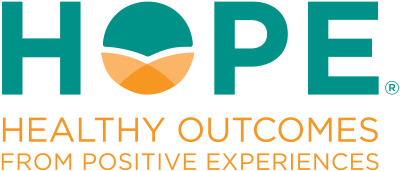
We’ve seen it in the results. I’ve actually heard from people in our agency that have said, you know, your teacher seems so much happier just from one year to the next. So it’s [HOPE framework is] really, really making a big difference in our organization.” Janice Smith, Oakland Livingston Human Service Agency
HOPE Champions helps reduce staff burnout in the education sector
When Veronica Pechumer, Flavia Maccio and Jessica Trotter from the Great Start Collaborative in the Oakland School District in Michigan heard that their partner organization Head Start Michigan was struggling with staff retention, a lightbulb went off. The three had become HOPE Champions and had already been applying it to their work providing support for young families with children. They’d done Introduction to HOPE workshops for home visitors and they’d offered the strengths-based approach to support physicians and families to better work together to meet healthcare goals for their children.
They thought: Staff burnout? Perhaps a strengths-based approach could work there, too.
“They were actually losing classrooms because they couldn’t keep teachers in them,” said Pechumer, Director of Great Start Collaborative at Oakland Schools. “It’s a high burnout rate because you’re working with … low pay on top of having the staffing crisis.”
Pechumer said that one of the presentation slides from the HOPE Champion training jumped out in her memory. It was about doing research on preventing burnout. She and her team decided to see if they could help.
Using a strengths-based approach to increase staff retention
They connected with the HOPE National Resource Center and with the Center for the Study of Social Policy (CSSP) and said, “Okay, we have this opportunity [to support Head Start]. We want to put all these frameworks into work and see what kind of comes up from that,” said Maccio, Great Start Collaborative Coordinator.
Pechumer said that in the same way that you need to provide families with a strengths-based approach, you also need to find those strengths within staff.
“You can’t just say to staff, ‘here’s our goals.’ You have to say to the staff, what are your goals, and how do we jointly meet them together?’”
They met with Oakland Livingston Human Service Agency (OLHSA), one of Head Start’s grantees, who needed support with its team of 120. They assessed that OLHSA management and teacher staff needed to strengthen their communication and trust, and that that would go a long way to prevent staff burnout. They used the HOPE and Strengthening Families Protective Factors frameworks to help develop a workplace culture that included a communication plan, workplace norms and tips for weekly communication. The idea was for all communication, even just emails, to be strengths-based. And for staff and management to have more intentional contact, including an increase in 1:1 meetings.
Utilizing HOPE and Strengthening Families frameworks to create positive internal changes
In Pechumer’s reflection on what the HOPE framework added to their plan to improve workplace culture, she said: “We’ve been training for a very long time in [The] strengthening families framework.. and one of the reasons that I fell in love with HOPE is … how it fits like a puzzle piece with Strengthening Families.”
“This is a perfect training to have both of these,” she said. “To talk about how to build those positive experiences with children … and support families with those protective factors … it just felt like such a great marriage.”
They used a survey to collect data on whether the new workplace culture was taking off. The questions centered around themes of belonging, safety, and connection, inspired by the Four Building Blocks of HOPE, key types of positive childhood experiences (PCEs) that all children need to thrive. For example, staff had to rate how true the following statements were for them over the course of 3 surveys:
- I have the resources to provide an environment where children feel valued and receive high quality education.
- I am accepted and understood by my team.
- There is transparent communication about important organizational decisions.
While it’s hard to directly measure staff retention, by the third round of surveys, after providing continued support and training for management and staff, the data showed a 0.7 point increase on a 5-point scale in staff feeling valued for their work, and a 0.35 point increase in those less likely to consider leaving the organization. These shifts represent significant improvement in both areas.
Improving staff culture improves experiences for children and families
Janice Smith, the early childhood director at OLHSA, said, “We’ve seen it in the results. I’ve actually heard from people in our agency that have said, you know, your teacher seems so much happier just from one year to the next. So it’s really, really making a big difference in our organization.”
These results are heartening for OLHSA. But beyond just preventing burnout, Pechumer pointed out that improving staff culture also has ripple effects toward the children and families that they are ultimately trying to support. She said the OLHSA team was more reflective on “How are we interacting with each other? But also, are we helping families interact with each other?” She said “it was not necessarily our goal, but it happened.”
The Great Start Collaborative plans to do one final survey to see if the staff morale stays at the level it reached.
What does the HOPE framework look like in your work?
Do you have an amazing story to share on how you are using the HOPE framework in your work with children and families? Are you looking to start prompting positive childhood experiences? Reach out to us!


